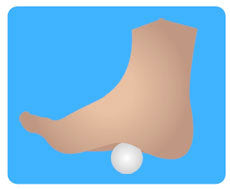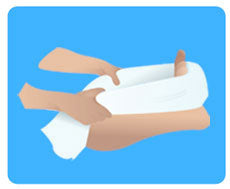3 helpful heel pain exercises
Three easy exercises to use with orthotics to overcome Heel Pain.
Studies from Europe and America have shown that by doing a few simple exercises every morning (and during the day) combined with wearing orthotics will help relieve Heel Pain and Plantar Fasciitis.
IMPORTANT: The stretching exercises below should create a pulling feeling only, they should never cause any pain. Therefore, please be careful when doing these exercises - don't overdo it!
Exercise 1) Rolling a tennis or golf ball under the foot
After sleeping or resting your Plantar Fascia tighten and shorten. Hence the sharp pain with your first steps out of bed in the morning. The exercise below helps make the Plantar Fascia supple and flexible. You can do this exercise any time of the day, even when you're watching TV or reading a book.
Get a golf ball, tennis ball, rolling pin or empty beer bottle. While seated roll the ball with the arch of the foot back and forth from your heel to the toes. If this feels okay and doesn't hurt you can take it further by doing this exercise while you are standing up, making the exercise a lot stronger. Keep doing this for about 4 minutes.

Exercise 2) Stretching the Plantar Fascia with a towel
Sit on the ground or on your bed and and place a rolled up towel around the toes. Holding the towel at both ends, pull the towel towards you while keeping your leg straight. Hold this position for 20 seconds. Repeat 4 times. You can make this exercise stronger by pulling harder. You should feel a strong stretch under the foot and also at the back of the heel and in your calf muscles.

Exercise 3) Stretching the calf muscles
Tight calf muscles are a major contributing factor to Plantar Fasciits and heel pain. Keeping your calves flexible will greatly reduce the tension in the Plantar Fascia, thereby preventing the occurrence of Plantar Fasciitis.
Stand up and place your hands against the wall at about eye level. Put one leg about a step behind your other leg, so that one leg is straight and the other one bent. Keep the heel of the straight leg on the floor and lean forward. You should feel a strong pull in the calves. Hold this position for about 20 seconds and repeat 4 times.
You can do this exercise during day, say 2 or 3 times a day and importantly before any sports, running or walking.

Studies & research in regards to orthotics Plantar Fasciitis
Heel Pain Study 1)
The American Orthopaedic Foot and Ankle Society (AOFAS) announced today the results of a two-year prospective randomized national study on the treatment of heel pain. The study found inexpensive off-the-shelf shoe inserts to be more effective than plastic custom arch supports in the initial treatment of heel pain (plantar fasciitis). Potentially, this finding could save more than $200 million in health care costs annually.
Heel pain affects over two million Americans annually and is the most common foot problem seen in medical practice. Non-operative care for heel pain provides satisfactory treatment for 90 percent of patients. However, research has not established which initial non-operative care is best. The current study, involving 15 orthopaedic foot and ankle centers, was designed to answer this question.
The investigation, conducted by the AOFAS Heel Pain Study Group, looked at the effectiveness of stretching exercises and orthotic devices in the treatment of heel pain. The researchers examined 236 patients who had no previous treatment for their heel pain and no serious medical problems.
The patients were divided (randomized prospectively) among five treatment groups. One group did only Achilles tendon and plantar fascia stretching exercises. (The plantar fascia is the band of tissue that stretches from the ball of the foot to the heel.) The other four groups used an off-the-shelf orthotic shoe insert along with the stretching exercises. All of the patients were examined by an orthopaedic foot and ankle specialist and asked to fill out an activity and symptom questionnaire. They returned after eight weeks of treatment for a repeat examination and questionnaire.
Seventy-two percent of those who did only Achilles tendon and plantar fascia stretching improved. Ninety-five percent of those who used orthotic insoles improved.
Conclusions:
The study clearly demonstrates that a stretching program plus an inexpensive pharmacy-bought orthotic insole is the best and most cost effective treatment for heel pain," said Glenn Pfeffer, M.D., San Francisco, Chairman of the AOFAS Heel Pain Study Group. "These findings will allow patients and the health care system to save hundreds of millions of dollars each year by avoiding the unnecessary prescription of a rigid custom arch support for the initial treatment of heel pain."
Heel Pain Study 2)
Tissue-specific plantar fascia-stretching exercise enhances outcomes in patients with chronic heel pain. A prospective, randomized study.
In this study, plantar fascia specific stretching was evaluated in 101 patients with chronic plantar fasciitis. The patients studied had diagnosed plantar fasciitis for at least 10 months. The patients were divided into two groups. The first group was given a plantar fascia tissue-stretching program and the second group was given an Achilles tendon-stretching program. All patients were educated by a video on plantar fasciitis, were given specific insoles and an anti-inflammatory medication for 3 weeks.
At 8 weeks, 82 patients had completed the therapy regimen and were reevaluated. The patients with the plantar fascia specific stretching program showed statistically significant improvement compared with the Achilles tendon stretching program.
Conclusions:
A plantar fascia specific stretching program provides more benefit than an Achilles tendon stretching program, for those with plantar fasciitis.
J Bone Joint Surg Am. 2003 Jul;85-A(7):1270-7
Heel Pain Study 3)
Comparison of custom and prefabricated orthoses in the initial treatment of proximal plantar fasciitis.
Forty-three patients with plantar fasciitis were divided into three treatment groups; treatment with orthotics, orthotics and night splints or night splints alone. After one year, 88 % of the patients returned for follow up evaluation and all treatment groups had significant improvement compared to their initial evaluation. At one year, the two groups using orthotics had a reduction in pain of 62% compared to a reduction of 48% with the group using only night splints.
Conclusions:
Patients with plantar fasciitis were more likely to continue to use orthotics than the night splint at one year. Note: night splints are generally used for a few months of treatment.
Foot Ankle Int. 2006 Aug;27(8):606-11.
Heel Pain Study 4)
Journal of Orthopaedic & Sports Physical Therapy, Official Publication of the Orthopaedic and Sports Physical Therapy Sections of the American Physical Therapy Association
The Impact of Foot Orthotics on Pain and Disability for Individuals With Plantar Fasciitis
Conclusions:
Semirigid foot orthotics may significantly reduce pain experienced during walking, and may reduce more global measures of pain and disability for patients with chronic plantar fasciitis. Our results were obtained within a relatively short period of time for subjects who had experienced chronic symptoms associated with plantar fasciitis, and who had used multiple interventions before using the semirigid foot orthotics provided during the study. Semirigid foot orthotics similar to the ones used in this study may be a cost-effective intervention for plantar fasciitis considering the limited number of clinic visits required to fabricate and adjust the orthotics.
Heel Pain Study 5)
The Short Term Treatment of Plantar Fasciitis Using Simple “off the shelf “ Foot Orthotics.
Department of Podiatry, Curtin University, Kent Street, Bentley, Perth Western Australia .
Conclusions:
Simple off the shelf (pharmacy or website bought) orthotics do have a significant effect on plantar fascia symptoms in this patient group. This finding supports the current literature.
